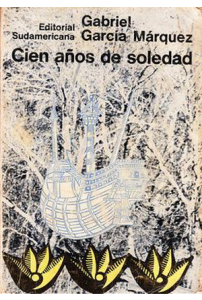| Title: | A Clockwork Orange |
| Author: | Anthony Burgess |
| Publisher: | William Heinemann Ltd |
| Location: | London United Kingdom |
| Published: | May 14, 1962 |
| Genre: | Dystopia, Literature |
| Pages: | 196 |
| Print Run: | 6,000 |

One Hundred Years of Solitude is a novel by Gabriel García Márquez, published by Editorial Sudamericana in 1967.
First Edition Identification Points
All of the following points must be present to ensure a true first edition / first printing.
- The copyright page has the following text:
SE TERMINÓ DE IMPRIMIR EL DÍA
TREINTA DE MAYO DEL AÑO MIL NO-
VECIENTOS SESENTA Y SIETE EN LOS
TALLERES GRÁFICOS DE LA COMPAÑÍA
IMPRESORA ARGENTINA, S. A., CALLE
ALSINA No 2049 – BUENOS AIRES
- Back cover has a paragraph about the author and his work that begins: “Gabriel García Márquez nació en 1928 en Aracataca, Colombia…”
- Front cover has an image of a blue and white galleon floating in front of a jungle, as well three orange flowers blooming up from the bottom
- Octavo, paper wrappers (soft cover)
Later Editions’ Identification Points
The applicable printing numbers are listed in brackets when known.
- The copyright page of the second print has the following text:
Portada de VICENTE ROJO
IMPRESO EN LA ARGENTINA
Queda hecho el depósito que previe-
ne la ley 11.723 © 1967, Editorial
Sudamericana Sociedad Anónima, ca-
lle Humberto 10 545 – Buenos Aires
- The copyright page of the third print has the following text:
SE TERMINÓ DE IMPRIMIR EL DÍA
ONCE DE SETIEMBRE DEL AÑO MIL
NOVECIENTOS SESENTA Y SIETE EN
LOS TALLERES GRÁFICOS DE LA COM-
PAÑIA IMPRESORA ARGENTINA, S. A.,
CALLE ALSINA 2049 – BUENOS AIRES
- The front and back covers both have a design with 9 blue frames filled with black and red symbols [2-4]
- The front cover has the author and title in red letters with the “E” in “SOLEDAD” flipped horizontally [2-4]
Publication History
Gabriel García Márquez (born Gabriel José de la Concordia García Márquez and known colloquially as Gabo or Gabito) had always wanted to write a novel based loosely around his own upbringing (large family in a Colombian town). In fact, Márquez had started a version of the book entitled The House when he was eighteen years old. The story percolated in his mind for decades as he worked for news and advertising agencies, as well as writing other stories. Then, in July 1965 as Márquez was driving his family to Acapulco on vacation, the story came to him and needed to be started immediately so he turned the car around and drove back to Mexico City to begin writing. He quit his job and his family began to live off of their savings. For 13 months Márquez wrote the novel and apparently smoked 30,000 cigarettes and spent 120,000 pesos. In early 1966 Mercedes sold their car, a white Opel; after the money from the car ran out, she pawned almost all of their possessions and asked for food and rent on credit. The book was finished in August 1966 and Gabriel and Mercedes took the manuscript to the post office to mail it to the publishing house Editorial Sudamericana in Buenos Aires. The cost of postage was 82 pesos, but they only had 53 between them. They sent as much of the manuscript as they could afford, but later realized they had accidentally sent the second half of the book instead of the first. According to Marquez, the editor at Editorial Sudamericana, Francisco “Paco” Porrúa, sent them the money to mail the rest of the book.
The cover of the book was intended to be designed by artist and Márquez’ friend Vicente Rojo, but Rojo failed to finish his piece before the deadline for the print date. The cover for the first edition was thus designed by an in-house designer, Iris Pagano, who made the image of a blue galleon floating over a jungle with three orange flowers blooming up from the bottom. The initial print run was expanded from 3,000 to 5,000 and then, two weeks before publication, 8,000 as the hype around the book grew. Cien Años de Soledad was published in Spanish in a soft-cover edition on May 30, 1967 in Buenos Aires. The book was immediately successful and numerous printings followed soon thereafter, all of which featured Vicente Rojo’s design of various symbols in nine blue frames on the front and back covers. The book was soon translated and published internationally, including in 1970 in English by Harper and Row. Márquez was awarded the Nobel Prize for Literature in 1982.
